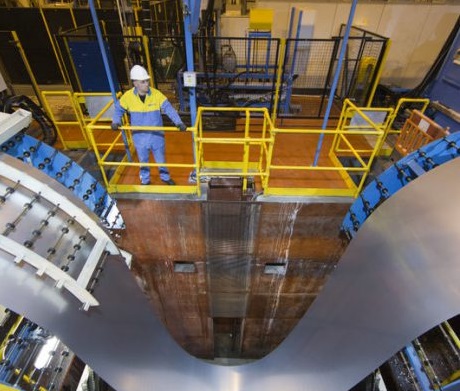5 things construction can learn from automotive
On a recent visit, Constructing Excellence was hosted by Tata Steel at its distribution and processing centre at Wednesfield, West Midlands, the largest in the UK. Tata Steel has invested heavily in the facility including more than £12m in a dedicated Automotive Service Centre to produce sophisticated differentiated steel products.
The visit inspired questions around how the business case was made for the automotive investment.
Contents |
[edit] 1. Long term relationships
Suppliers invest in production facilities on the basis of long-term and certain demand based on standardisation and systemisation, making it easier to make long-term investments in manufacturing facilities.
It can take two years of discussions with clients before a part gets put on the production line. The steel industry is not without risks but those risks are clearly identified and understood so investments can be justified.
[edit] 2. Is lack of people a good thing?
The group were struck by the limited number of people on the shop floor, prompting a debate about whether reduced labour requirements associated with the manufacturing revolution was a good thing. Levels of automation mean a higher level of training and therefore opportunities to improve the workforce skillset and flexibility. High quality production and just-in-time service also require resources and training in quality assurance, planning and health, and safety to support the supply chain.
[edit] 3. Manufacturer-led construction?
The aim for manufacturers like Tata Steel is to change the perception of steel as just a commodity and to add value to get closer to its clients and really understand their requirements and how they define value. This requires a movement away from traditional supply chains towards more integrated supply chains.
[edit] 4. Can existing procurement practices support this?
Procurement processes are in place to manage risk, and particularly in the public sector to ensure fairness and transparency. There was a heated discussion about whether the existing complex supply chain can be open and whether they do deliver transparency and that current processes were skewed towards traditional delivery.
It was suggested that existing procurement processes can get in the way of early manufacturer engagement and limit some of the advantages of offsite. Moreover, passing risk down the supply chain has the effect of multiplying risk.
[edit] 5. Generative design tools
Generative design tools and a platform-based approach with a pallet of products will help construction take better advantage of manufacturing and its added value. This relates to the work that Constructing Excellence member Blacc has been undertaking to identify a kit of parts for the education sector that can be configured to suit specific site and client requirements, while still meeting Education Funding Agency requirements at higher spec and lower costs.
Alex Lubbock, head of digital construction at the Infrastructure Projects Authority, led a discussion on how the IPA’s Transforming Infrastructure Performance programme is designed to support government engagement with industry to shift to a presumption in favour of offsite outlined in the autumn budget of 2017.
Some of the key areas include:
- Finding ways to enable early manufacturer engagement while remaining compliant with European procurement regulations. This will enable tenders and procurement to be delivered in a way that supports innovation and SME involvement.
- Generating a pipeline of repeatable projects and elements that can unlock long-term investment and enable the industry to build on knowledge and transfer learning more effectively between projects.
Throughout the visit, the message was reinforced that early decisions on offsite were required in order to deliver real value for clients.
This article was originally published here on 7th Feb 2018 by BRE Buzz.
--BRE Buzz
[edit] Related articles on Designing Buildings Wiki
Featured articles and news
Lighting Industry endorses Blueprint for Electrification
The Lighting Industry Association fully supports the ECA Blueprint as a timely, urgent call to action.
BSRIA Sentinel Clerk of Works Training Case Study
Strengthening expertise to enhance service delivery with integrated cutting-edge industry knowledge.
Impact report from the Supply Chain Sustainability School
Free sustainability skills, training and support delivered to thousands of UK companies to help cut carbon.
The Building Safety Forum at the Installershow 2025
With speakers confirmed for 24 June as part of Building Safety Week.
The UK’s largest air pollution campaign.
Future Homes Standard, now includes solar, but what else?
Will the new standard, due to in the Autumn, go far enough in terms of performance ?
BSRIA Briefing: Cleaner Air, Better tomorrow
A look back at issues relating to inside and outside air quality, discussed during the BSRIA briefing in 2023.
Restoring Abbotsford's hothouse
Bringing the writer Walter Scott's garden to life.
Reflections on the spending review with CIAT.
Retired firefighter cycles world to raise Grenfell funds
Leaving on 14 June 2025 Stephen will raise money for youth and schools through the Grenfell Foundation.
Key points for construction at a glance with industry reactions.
Functionality, visibility and sustainability
The simpler approach to specification.
Architects, architecture, buildings, and inspiration in film
The close ties between makers and the movies, with our long list of suggested viewing.
SELECT three-point plan for action issued to MSPs
Call for Scottish regulation, green skills and recognition of electrotechnical industry as part of a manifesto for Scottish Parliamentary elections.
UCEM becomes the University of the Built Environment
Major milestone in its 106-year history, follows recent merger with London School of Architecture (LSE).
Professional practical experience for Architects in training
The long process to transform the nature of education and professional practical experience in the Architecture profession following recent reports.
A people-first approach to retrofit
Moving away from the destructive paradigm of fabric-first.
New guide for clients launched at Houses of Parliament
'There has never been a more important time for clients to step up and ...ask the right questions'
The impact of recycled slate tiles
Innovation across the decades.
EPC changes for existing buildings
Changes and their context as the new RdSAP methodology comes into use from 15 June.



























